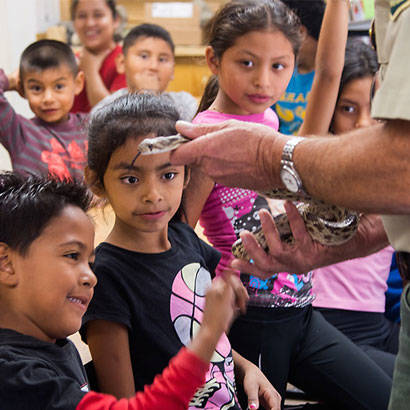
Under the Trump administration’s executive order to review national monuments designated since 1996, the U.S. Department of the Interior identified 27 monuments that could be scaled back or even eliminated. The list targets seven in California alone: the San Gabriel Mountains, Sand to Snow, Mojave Trails, Berryessa Snow Mountain, Giant Sequoia, Carrizo Plain and Cascade Siskiyou National Monuments. Recently, Ryan Zinke, the interior secretary, issued an interim report on reductions to the 1.35 million-acre Bears Ears monument in Utah. He is set to submit a report by August 24 with recommendations for changes to monuments from Maine to California, as well as marine monuments in the Atlantic and Pacific oceans.
Now is the time to defend our national heritage. The review targets and threatens monuments that focus on the history and culture of diverse communities. An attack on one monument is an attack on all monuments. The order is an attack on the Antiquities Act, on the rule of law, and on democratic governance. We, the people, are the ultimate check on government. We must protect our monuments, and hopefully, before the July 10 deadline, more than 250,000 public comments will be submitted to save the monuments.
“If we want our system of parks and public lands to reflect the incredible diversity of America, then the Antiquities Act is a crucial tool for achieving that goal. Congress is not always able or willing to act quickly enough — or frankly creatively enough — to recognize and preserve sites with cultural or historic significance. Without the act, we might not have sites honoring people like Cesar Chavez or Harriet Tubman or events like Stonewall,” says Arizona Rep. Raúl Grijalva, top Democrat on the House Committee on Natural Resources. Ranking Members Grijalva, Nydia Velásquez and Tim Waltz of the Committees on Natural Resources, Veterans Affairs, and Small Business held a forum on the Hill, June 8, on the order.
A diverse group of advocates testified on the values at stake: Hugo Turek, a Montana rancher, testified that even a rural state with more cattle than people needs monument protection. Megan Duffy from retailer Patagonia testified about economic benefits of outdoor recreation -- $887 billion and 7.6 million jobs per year. Carrie Hamblen, CEO and president of Las Cruces Green Chamber of Commerce and an LGBTQ leader, testified about civic pride and civic engagement in support of White Sands, Prehistoric Trackways and Organ Mountains-Desert Peaks monuments. Robert Vessels, a U.S. Army veteran, testified about empowering service members, their families and veterans by providing access to the outdoors and developing volunteer leadership skills. I testified on behalf of the Next 100 Coalition, which supports public lands and waters for all; GreenLatinos, an international network of conservation, environmental justice, and health equity allies; and San Gabriel Mountains Forever.
Support the San Gabriel Mountains National Monument
The San Gabriel Mountains Forever coalition has worked for more than a decade to earn local support for this monument. The official Community Collaborative has worked with the U.S. Forest Service for three years developing the management plan. Community needs have driven designation and planning from the start. “We were able to come up with a document that we can all support, which is the first time this has been done when a national monument has been designated to serve the recreational needs of such a large, urban population,” says Liz Reilly, city of Duarte, California, councilwoman, and a member of the San Gabriel Valley Council of Governments.
The monument serves 15 million Los Angeles residents in the nation’s second largest urban center, includes 350,000 acres of the Angeles and San Bernardino National Forests, and logs more than 4 million visits per year. It holds evidence of more than 8,000 years of human history and 600 archeological sites, and hosts a wide variety of year-round activities. The area provides Angelinos with 70 percent of their open space and 30 percent of their drinking water. And, in Los Angeles County, which is park poor, this monument promotes equal access to parks, waters, recreation, climate justice, health equity, quality jobs and education, especially for low income children and children of color. Civil rights groups, health equity and social justice advocates, Native Americans, youth leaders, conservation groups, local governments, gun owners, hunters, hikers, cabin owners, off-road vehicle users and businesses oppose this review.
Celebrate the Values at Stake
This review denigrates the work that brought diverse communities together, from those in urban neighborhoods providing equal access to nature and recreation, to others protecting cultural identity. It puts the interest of oil drilling and mining companies, big business and developers ahead of the needs of the people.
Thirty Native American tribes came together to support Bears Ears in Utah, the first target of the review, which celebrates the earth and her people, sacred cultural sites and ancient artifacts. Mojave Trails, Sand to Snow and Castle Mountains National Monuments also protect and celebrate Native American history, values and culture. Their history is our common history.
Support the Antiquities Act
Since 1906, 16 presidents, Republican and Democrat, have used the Antiquities Act to preserve 152 national monuments. It is one of the nation’s oldest and most successful laws to conserve our environment and cultural heritage and should be preserved.
We urge you to stand in solidarity and resistance with we, the people, to support national monuments and the Antiquities Act for all. Visit www.monumentsforall.org for a complete list of monuments under attack and to submit comments.
Robert García is Founding Director and Counsel of The City Project, and a member of Next 100, GreenLatinos, and the San Gabriel Mountains Forever and Community Collaborative.

